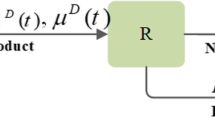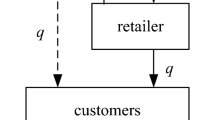Abstract
Firms have seen rising costs on one side of the supply chain, and frugal shoppers on the other end in today’s business environment. It is possible that increment of rising costs will be passed on to consumers. How will these organizations that are seeking trade promotion decide on passthrough rate in a supply chain? We build a model to analyze both the own-brand and cross-brand cost pass-through incentives of a supply chain selling two products. The key contributions of this paper are as follows. First, we formulate a general pass-through problem as a comparative static of the price equilibrium in a channel duopoly. Our model considers (1) competition intensity, (2) consumer marginal willingness to pay (MWTP), (3) consumer perceivable difference as a threshold level to compare utility from consuming different products, and (4) product quality difference. We show that whether retail cross-brand passthrough is positive, zero or negative depends on whether the hazard rate of consumer MWTP is increasing, affine or decreasing; whether the supplier own-brand and cross-brand pass-through is strictly increasing, affine or decreasing depends on whether the reciprocal of the consumer MWTP hazard rate is strictly increasing, affine or decreasing. Second, we use this model to compare differences in pricing decisions and in profits, resulting from using a centralized versus a decentralized chain in both monopoly and duopoly markets. Our approach allows us to derive pricing implications in both monopoly and duopoly settings.


Similar content being viewed by others
Notes
Mills ratio is the reciprocal of the failure rate or hazard rate, see Grimmett and Stirzaker (2001).
We use \(m^{\prime }(\cdot )\) to represent \(\frac{dm(\cdot )}{d(\cdot )}, m^{\prime \prime }(\cdot )\) to represent \(\frac{d^{2}m(\cdot )}{d(\cdot )^{2} },\) and so on.
We use \(m^{\prime }(\cdot )\) to represent \(\frac{dm(\cdot )}{d(\cdot )}, m^{\prime \prime }(\cdot )\) to represent \(\frac{d^{2}m(\cdot )}{d(\cdot )^{2} },\) and so on.
We use \(m^{\prime }(\cdot )\) to represent \(\frac{dm(\cdot )}{d(\cdot )}, m^{\prime \prime }(\cdot )\) to represent \(\frac{d^{2}m(\cdot )}{d(\cdot )^{2} },\) and so on.
The Negative Binomial distribution, which is used to model the number of “successes” in a sequence of Bernoulli trials before \(r\) “failures” is both DFR (decreasing Failure Rate) and IGFR when \(r\in (0,1]\).
References
Ailawadi, K., Bradlow, E., Draganska, M., Nijs, V., Rooderkerk, R., Sudhir, K., et al. (2010). Empirical models of manufacturer–retailer interaction: A review and agenda for future research. Marketing Letters, 21(3), 273–285.
Alexei, A., & Ozlem, B. (2011). Asymmetric demand effects and cost pass-through. Simon School Working Paper No. FR 11-12.
Baricz, A. (2010). Geometrically concave univariate distributions. Journal of Mathematical Analysis and Applications, 363, 182–196.
Besanko, D., Dube, J.-P., & Gupta, S. (2005). Own-brand and cross-brand retail pass-through. Marketing Science, 24(1), 123–137.
Bulow, J. I., & Pfleiderer, P. P. (1983). A note on the effects of cost changes on prices. Journal of Political Economy, 91, 181–185.
Cattani, K., & Heese, S. (2009). Seeking closure: Competition in complementary markets. Decision Sciences, 40(4), 817–843.
Chen, J., & Bell, P. C. (2013). The impact of customer returns on supply chain decisions under various channel interactions. Annals of Operations Research, 206(1), 59–74.
Chiu, C., Choi, T., & Li, D. (2009). Price wall or price war: The pricing strategies for retailers. IEEE Transactions on Systems, Man, and Cybernetics—Part A, 39, 331–343.
Choi, T. M., Chiu, C. H., & Fu, P. L. (2011). Periodic review multi-period inventory control under a mean-variance optimization objective. IEEE Transactions on Systems, Man and Cybernetics, Part A, Systems and Human, 41(4), 678–682.
Dube, J.-P., & Gupta, S. (2008). Cross-brand pass-through in supermarket pricing. Marketing Science, 27(3), 324–333.
Georgescu-Roegen, N. (1958). Threshold in choice and the theory of demand. Econometrica, 26, 157–168.
Grimmett, G., & Stirzaker, S. (2001). Probability theory and random processes (3rd ed., p. 98). Cambridge.
Horvath, C., & Fok, D. (2013). Moderating factors of immediate, gross, and net cross-brand effects of price promotions. Marketing Science, 32(1), 127–152.
Jain, D. C., Vilcassim, N. J., & Chintagunta, P. K. (1994). A random coeffecients logit brand choice model applied to panel data. Journal of Business and Economic Statistics, 12, 317–328.
Kim, S. Y., & Staelin, R. (1999). Manufacturer allowances and retailer pass-through rates in a competitive environment. Marketing Science, 18(1), 59–76.
Kreps, D. M. (1990). Game theory and economic modelling. Oxford: Oxford University Press.
Krishnan, K. S. (1977). Incorporating thresholds of indifference in probabilistic choice models. Marketing Science, 23, 1224–1233.
Kumar, N., Rajiv, S., & Jeuland, A. (2001). Effectiveness of trade promotions: Analyzing the determinants of retail pass through. Marketing Science, 20, 382–404.
Lariviere, M. A. (2006). A note on probability distributions with increasing generalized failure rates. Operations Research, 54(3), 602–604.
Lioukas, S. K. (1984). Thresholds and transitivity in stochastic consumer choice: A multinomial logit analysis. Management Science, 30(1), 110–122.
Liu, Z., & Nagurney, A. (2013). Supply chain networks with global outsourcing and quick-response production under demand and cost uncertainty. Annals of Operations Research, 208(1), 251–289.
López-Milán, E., & Plà-Aragonés, L. M. (2014). A decision support system to manage the supply chain of sugar cane. Annals of Operations Research, 219, 285–297.
McAlister, L. (2007). Cross-brand pass-through: Fact or artifact. Marketing Science, 876–898.
MEI Computer Technology Group Inc. (2011). 2011 Trade promotion management trends.
Moorthy, S. (2005). A general theory of pass-through in channels with category management and retail competition. Marketing Science, 24(1), 110–122.
Nijs, V., Misra, K., Anderson, E., Hansen, K., & Krishnamurthi, L. (2010). Channel pass-through of trade promotions. Marketing Science, 29(2), 250–267.
Sethuraman, R. (2009). Assessing the external validity of analytical results from national brand and store brand competition models. Marketing Science, 28, 759–781.
Simon, H. (1965). Administrative behaviour. London: Macmillan.
Simon, H. (1979). Rational decision making in business organisations. American Economic Review, 69, 493–513.
Tyagi, R. K. (1999). A characterization of retailer response to manufacturer trade deals. Journal of Marketing Research, 36, 510–516.
van den Berg, G. J. (2007). On the uniqueness of optimal prices set by monopolistic sellers. Journal of Econometrics, 141(2), 482–491.
Wallace, D. W., Johnson, J. L., & Umesh, U. N. (2009). Multichannels strategy implementation: The role of channel alignment capabilities. Decision Sciences, 40(4), 869–900.
Xu, X., & Hopp, W. J. (2009). Price trends in a dynamic pricing model with heterogenous customers: A martingale perspective. Operations Research, 57(5), 1298–1302.
Zheng, J., Chiu, C. H., & Choi, T. M. (2012). Optimal advertising and pricing strategies for luxury fashion brands with social influences. IEEE Transactions on Systems, Man and Cybernetics, Part A, Systems and Human, 42(4), 827–837.
Acknowledgments
This work is partially supported by NFSC grant (Grant # 71471055), the 100-Talents plan Program at Chinese Academy of Sciences and 1000-Talents Plan Program for Young Scientists, in part by Chinese Academy of Sciences Visiting Professorship for Senior International Scientists. Grant No. 2013T2J0054.
Author information
Authors and Affiliations
Appendix
Appendix
Proof of Proposition 1
Taking the second derivative in (9) and (10) with respect to \(c_{i}^{{}}\)(\(i\in \{1,2\}, j=3-i\)) leads to:
where we use \(m^{\prime }(\cdot )\) to represent \(\frac{dm(\cdot )}{d(\cdot )}, m^{\prime \prime }(\cdot )\) to represent \(\frac{d^{2}m(\cdot )}{d(\cdot )^{2}}\). Denote by \(m^{{}}(\delta )=m(\frac{p_{i}-p_{j}+\delta }{q_{i}-q_{j}} )\) and \(m^{{}}(-\delta )=m(\frac{p_{i}-p_{j}-\delta }{q_{i}-q_{j}})\) for simplicity, solving the system of equations in (12) and (13) with respect to \(\frac{\partial ^{2}p_{i}}{\partial c_{id}^{2}} \) and \(\frac{\partial ^{2}p_{j}}{\partial c_{id}^{2}}\) leads to:
where \(\varkappa =\frac{1}{(q_{i}-q_{j})(m^{\prime }(\delta )+m^{\prime }(-\delta )-1)^{2}}>0\). For the convex Mills Ratio \(m^{\prime \prime }\left( \cdot \right) \ge 0\) that follows from Assumption (iii), then \(\frac{\partial ^{2}p_{i}}{\partial c_{id}^{2}}\ge 0\) and \(\frac{\partial ^{2}p_{j} }{\partial c_{id}^{2}}\ge 0\) due to both \(m^{\prime }(\delta )<0\) and \( m^{\prime }(-\delta )<0\). Otherwise, for the concave Mills Ratio \(m^{\prime \prime }\left( \cdot \right) <0\), then \(\frac{\partial ^{2}p_{i}}{\partial c_{id}^{2}}\le 0\) and \(\frac{\partial ^{2}p_{j}}{\partial c_{id}^{2}}\le 0\). This completes the proof. \(\square \)
Proof of Proposition 2
(a) Differentiating both sides in (24) with respect to \( c_{i}\) yields
where (33) follows from the chain rule and (34) follows by the fact that the gap between retailer own-brand pass-through and cross-brand pass-through in both channels are the same, i.e., \(\frac{ \partial p_{i}}{\partial w_{i}^{{}}}-\frac{\partial p_{j}}{\partial w_{i}^{{}}}=\frac{\partial p_{j}}{\partial w_{j}^{{}}}-\frac{\partial p_{i}}{ \partial w_{j}^{{}}}\), (35) follows from substituting (20) and (21) into (34).
Switching the position of \(i\) and \(j\) in (24) and differentiating both sides in the resulting equation with respect to \(c_{i}\) yields
Solving the system of Eqs. (35) and (36) for \( \frac{\partial w_{i}}{\partial c_{i}^{{}}}\) and \(\frac{\partial w_{j}}{ \partial c_{i}^{{}}}\) leads to
where \(\frac{\partial w_{i}}{\partial c_{i}^{{}}}>\frac{1}{2}\) and \(\frac{ \partial w_{j}}{\partial c_{i}^{{}}}<\frac{1}{2}\) holds due to the fact that \(2-\frac{1-m^{\prime }(\delta )-m^{\prime }(-\delta )}{T^{\prime }}>2\) from (20) and \(T^{\prime }(\cdot )<0\).
(b) (37) and (38) implies that supplier own-brand pass-through and cross-brand pass-through in both channels are the same, i.e., \(\frac{\partial w_{i}}{\partial c_{i}^{{}}}=\frac{\partial w_{j}}{ \partial c_{j}^{{}}}\) and \(\frac{\partial w_{j}}{\partial c_{i}^{{}}}=\frac{ \partial w_{i}}{\partial c_{j}^{{}}}\).
Substituting (20), (21), (37) and (38) into (34) yields the channel own-brand and cross-brand pass-through:
This completes the proof. \(\square \)
Proof of Proposition 3
Using the threshold-based divisible Mills Ratio, we can rewrite (37) and (38) as
Taking the first derivative in both sides of (39) and (40) with respect to \(c_{i}^{{}}\) and rearranging the result for \(\frac{\partial ^{2}w_{i}}{\partial c_{i}^{2}}\) and \(\frac{ \partial ^{2}w_{j}}{\partial c_{i}^{2}}\) yields the following
where (42) follows from substituting (37) into (41) and the last equality follows by use of the definition of \(\widehat{T}\). From (43) we see that \(\frac{\partial ^{2}w_{i} }{\partial c_{i}^{2}}>0\) if and only if \(\widehat{T}^{\prime }>0, \frac{ \partial ^{2}w_{i}}{\partial c_{i}^{2}}=0\) if and only if \(\widehat{T} ^{\prime }=0\) and \(\frac{\partial ^{2}w_{i}}{\partial c_{i}^{2}}<0\) if and only if \(\widehat{T}^{\prime }<0\) given that \(2\widehat{T}-1<0\). The same results hold for \(\frac{\partial ^{2}w_{j}}{\partial c_{i}^{2}}\) by use of exactly the same derivation process, which completes the proof. \(\square \)
Proof of Proposition 4
Solving the system of Eqs. (18) and (23) leads to analytical solutions
where \(A=48\delta -16c_{i}+36k\delta -12kc_{j}-48aq_{i}-34k^{2}\delta -24k^{3}\delta +6k^{4}\delta +4k^{5}\delta +14k^{2}c_{i}+10k^{3}c_{j}-3k^{4}c_{i}-2k^{5}c_{j}+12akq_{j}+70ak^{2}q_{i}-10ak^{3}q_{j}-30ak^{4}q_{i}+2ak^{5}q_{j}+4ak^{6}q_{i}, B=48\delta -16c_{j}+36k\delta -12kc_{i}-48aq_{j}-34k^{2}\delta -24k^{3}\delta +6k^{4}\delta +4k^{5}\delta +14k^{2}c_{j}+10k^{3}c_{i}-3k^{4}c_{j}-2k^{5}c_{i}+12akq_{i}+70ak^{2}q_{j}-10ak^{3}q_{i}-30ak^{4}q_{j}+2ak^{5}q_{i}+4ak^{6}q_{j}, C=-8\delta +8c_{i}-6k\delta +2kc_{j}+8aq_{i}+3k^{2}\delta +2k^{3}\delta -8k^{2}c_{i}-k^{3}c_{j}+2k^{4}c_{i}-2akq_{j}-9ak^{2}q_{i}+ak^{3}q_{j}+2ak^{4}q_{i},\) and \(D=-8\delta +8c_{j}-6k\delta +2kc_{i}+8aq_{j}+3k^{2}\delta +2k^{3}\delta -8k^{2}c_{j}-k^{3}c_{i}+2k^{4}c_{j}-2akq_{i}-9ak^{2}q_{j}+ak^{3}q_{i}+2ak^{4}q_{j}\).
Taking the first derivative of \(p_{i}^{*}\) and \(w_{i}^{*}\) with respect to parameters leads to
This completes the proof. \(\square \)
Rights and permissions
About this article
Cite this article
Wu, D. Pass-through decision analysis in a supply chain. Ann Oper Res 257, 297–316 (2017). https://doi.org/10.1007/s10479-015-1817-5
Published:
Issue Date:
DOI: https://doi.org/10.1007/s10479-015-1817-5




